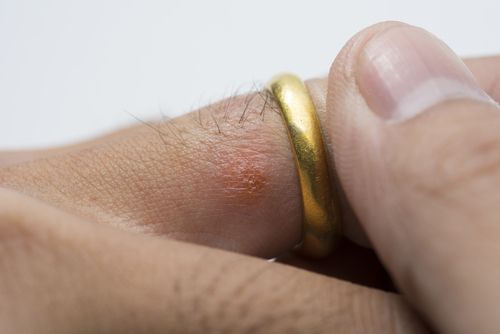 Wedding planning brings with it the inevitable to-do list, and for many couples, it includes purchasing wedding rings. This process goes smoothly most of the time, rewarding the couple with a beautiful pair of rings. But what happens when an uncomfortable rash forces you to take yours off? You could have a metal allergy, a frustrating but common condition. Learning more about it can help you shop smarter and choose the best wedding ring options.
Wedding planning brings with it the inevitable to-do list, and for many couples, it includes purchasing wedding rings. This process goes smoothly most of the time, rewarding the couple with a beautiful pair of rings. But what happens when an uncomfortable rash forces you to take yours off? You could have a metal allergy, a frustrating but common condition. Learning more about it can help you shop smarter and choose the best wedding ring options.
What Causes Metal Allergies?
Contact dermatitis is the fancy medical term for the annoying itch, redness, inflammation, and dry skin patches that develop around your finger. These allergic reactions occur when your immune system mistakes a substance for pathogens. Cleveland Clinic clarifies that skin cells can absorb tiny molecules of metal that travel to your lymph nodes. When your immune system misinterprets them as foreign bodies, it overreacts and mounts a defense as it would against normal pathogens.
Metal Alloys and Gold Jewelry
Jewelers produce metal alloy rings for three reasons: improving their durability, achieving specific colors, or providing consumers with affordable options. Gold is extremely soft in its natural state, so it’s frequently blended with other metals to make it harder. Gold purity is measured in karats, designated with the letter K. Karats measure the metal’s parts per 24, which is why 24K gold is considered pure. Common gold varieties 22K, 18K, and 14K are alloys containing other metals.
Common Allergy Triggers
A PubMed abstract from 2010 estimates that nearly 25% of adults have metal allergies. Most of these are nickel allergies, but some are adverse reactions to cobalt and chromium. Rarer cases include copper or brass, an alloy of copper and zinc.
Surprisingly, some varieties of gold can produce allergic reactions. That may sound odd, but remember that many of them are gold alloys. Rose gold, for example, blends copper and a tiny bit of silver to achieve its pink metallic hue. Red golds have the highest amount of copper, containing up to 50% in 12K jewelry pieces. Black gold contains either 25% cobalt or a cobalt-chromium mix. White golds are also common allergy triggers because some versions use nickel to achieve their pale colors.
Smart Ring Shopping Tips
If you haven’t purchased your wedding rings yet, you can avoid buying jewelry containing allergenic metals. Colored golds pose the most problems, but some yellow golds aren’t immune from copper content. For instance, some 18K gold contains 12.5% copper and 18K dark golds can contain up to 15% copper. When in doubt, ask the jeweler for information.
Most online retailers don’t list their rings’ alloy compositions, but keep in mind that most white gold in the United States contains nickel. Many companies apply rhodium plating to their white gold rings, forming a barrier between skin and metal. This plating eventually wears off, exposing the skin to nickel in the ring and triggering allergic reactions. If you prefer white gold, Bustle contributor Rika Nurrohmah suggests looking for rings with gold-palladium alloys. Platinum allergies are rare, so gold-platinum alloys may also be good choices.
Post-Wedding Allergy Solutions
Fortunately, couples who’ve already purchased their rings have a couple of options. Most retailers allow return and exchange periods of between 14 and 60 days, so you must act quickly. Your jeweler may offer rhodium plating, which lasts between 12 and 18 months depending on your lifestyle and body chemistry. You must have the plating reapplied regularly, but you can prolong its lifespan by keeping your ring dry and taking it off before exercising or other strenuous activities.
Discovering you’re allergic to metals in your wedding ring can be disheartening. Exchanging your ring or choosing rhodium plating are possible solutions, but careful shopping can prevent the problem entirely. Ask questions as you shop, and know what you’re buying before you hand over any money or sign any paperwork.
Add Your Comment